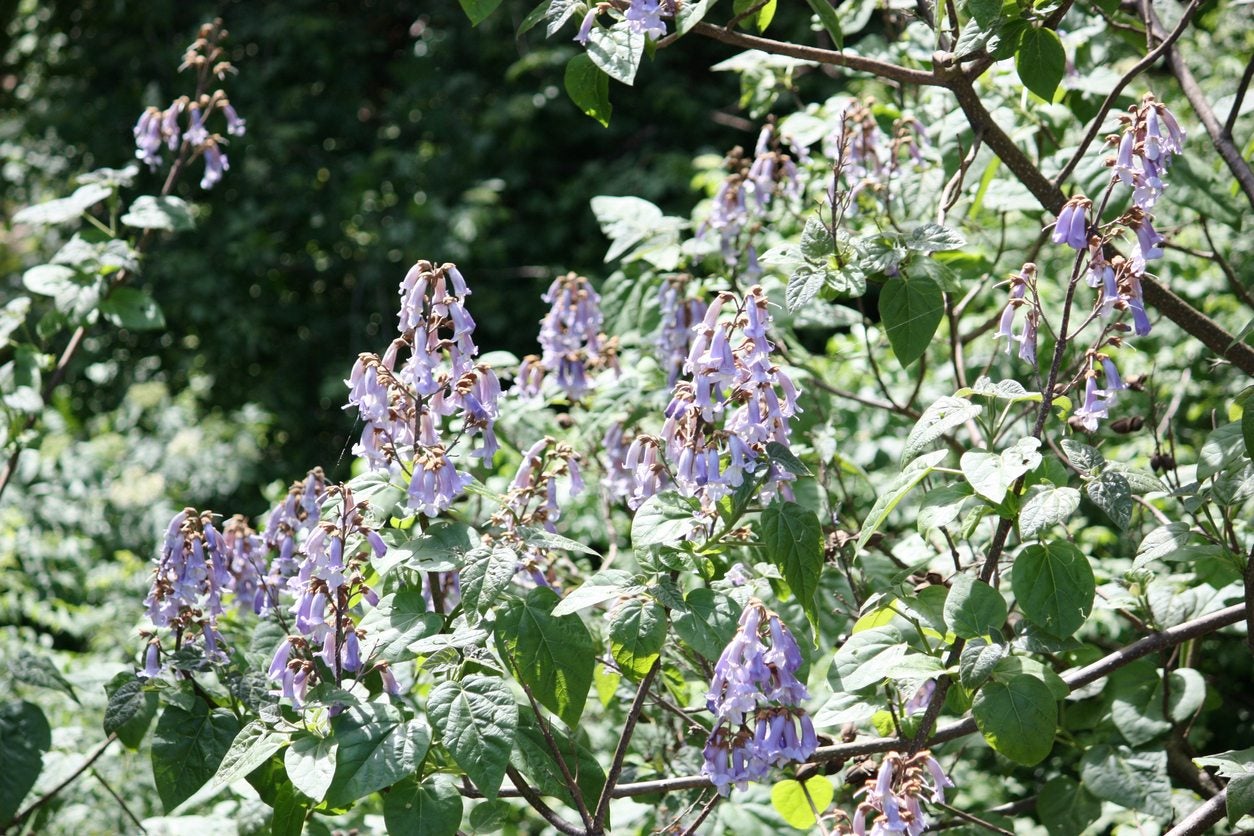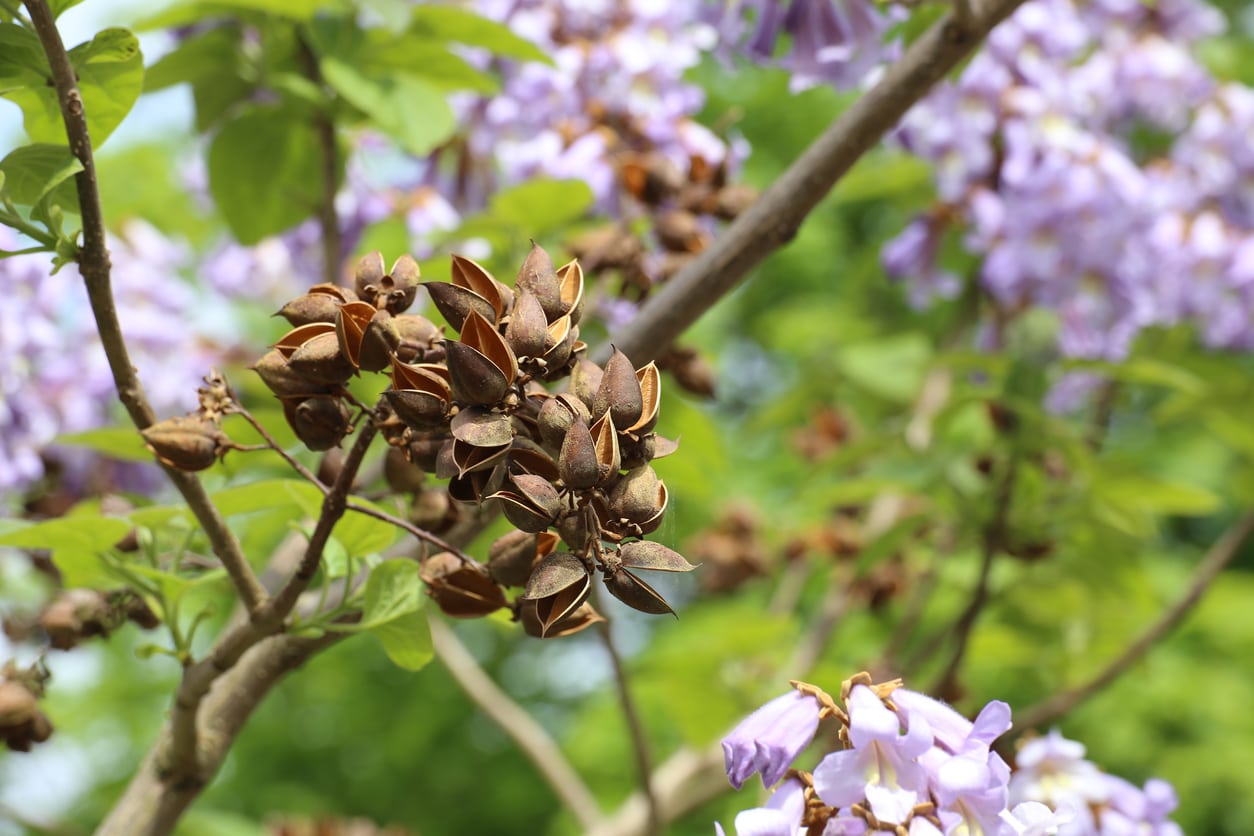Pruning An Empress Tree – Learn About Royal Paulownia Empress Pruning


Royal empress trees (Paulownia spp.) grow fast and produce large clusters of lavender flowers in springtime. This native of China can shoot up to 50 feet (15 m.) tall and wide. You need to start pruning royal empress trees early to help them develop a strong branch structure. If you want to know how to prune a paulownia and when to prune royal paulownia, read on.
Pruning an Empress Tree
The royal empress tree is dramatic and impressive, with large, heart-shaped leaves and lavender flowers. Since blossoms appear before the leaves open, they are especially showy and impressive. The royal empress tree grows extremely fast, up to 15 feet (5 m.) per year. One result of that speedy development is weak wood that is vulnerable to breakage. Poor collar formation can also make branches vulnerable to breaking off at the branch crotch. Proper royal paulownia empress pruning takes care of these problems.
How and When to Prune Royal Paulownia
The question of when to prune royal paulownia is closely related to the issue of how to prune a paulownia. The when and how both depend upon the result you want to achieve. One option is to prune the tree into a shorter garden-size plant. If you want to prune a paulownia like this, cut the tree back to about 4 feet (1 m.), leaving a few branches on this main trunk. Do this in the autumn. This type of pruning slows the rapid growth of the tree. Come spring, your tree’s branches will be filled with its trademark, heart-shaped leaves. The gorgeous blue flowers will also appear, filling the garden with a honeysuckle fragrance. If you want to expand those beautiful leaves to a yard (1 m.) across, cut them back very hard in the winter. Pruning an empress tree severely like this in winter causes new leaves to open every spring. The very short trunk puts out green branches with enormous heart-shaped leaves. If your intention in royal paulownia empress pruning is simply to strengthen the flowering tree, cut back dead wood in early spring. Don’t think of pruning royal empress severely at this time since you will eliminate the flowers. After flowering, you can start pruning an empress tree more severely. Take out damaged and overlapping branches. Remove branches with poor collar attachment. Remove lower branches to allow passage below the tree. If the tree appears spindly or crooked, cut it back to the ground and allow it to regrow. When it does, prune back all except the strongest shoot. It will grow in straight and strong.
Gardening tips, videos, info and more delivered right to your inbox!
Sign up for the Gardening Know How newsletter today and receive a free copy of our e-book "How to Grow Delicious Tomatoes".

Teo Spengler is a master gardener and a docent at the San Francisco Botanical Garden, where she hosts public tours. She has studied horticulture and written about nature, trees, plants, and gardening for more than two decades. Her extended family includes some 30 houseplants and hundreds of outdoor plants, including 250 trees, which are her main passion. Spengler currently splits her life between San Francisco and the French Basque Country, though she was raised in Alaska, giving her experience of gardening in a range of climates.
-
 Looking For Plants To Give You The Soft And Fuzzies? Try These 5 Fuzzy Leaf Plant Options
Looking For Plants To Give You The Soft And Fuzzies? Try These 5 Fuzzy Leaf Plant OptionsLovers of texture, drama, silver foliage and tactile plants will adore these special sensory garden additions. These fuzzy leaf plant options will leave you all aglow
By Susan Albert
-
 Get Ready For A Summer Of Hummers! Grow These Full Sun Hummingbird Plants and Flowers
Get Ready For A Summer Of Hummers! Grow These Full Sun Hummingbird Plants and FlowersIf you’re lucky enough to enjoy a sunny backyard, make sure you are maxing out on your pollinator opportunities and grow these full sun hummingbird plants and flowers
By Tonya Barnett
-
 Paulownia Seed Propagation: Tips On Growing Royal Empress From Seed
Paulownia Seed Propagation: Tips On Growing Royal Empress From SeedIf you are interested in growing royal empress from seed, as Mother Nature does, you’ll find that planting royal empress seeds is almost foolproof. For more information about royal empress seed germination, click on the following article.
By Teo Spengler
-
 Controlling Paulownia – Tips On Getting Rid Of Royal Empress Trees
Controlling Paulownia – Tips On Getting Rid Of Royal Empress TreesA royal pain in the rump is the Royal Empress tree, also known as Princess tree or Royal Paulownia. While getting rid of this extremely fast-growing tree may seem like a never-ending battle, click here to learn more about royal empress control.
By Shelley Pierce
-
 Royal Empress Tree: World's Fastest Growing Shade Tree
Royal Empress Tree: World's Fastest Growing Shade TreeInstant shade usually comes at a price. Normally, you'd have one of more disadvantages from trees that grow super fast. Here you can learn about growing a Royal Empress tree and its benefits.
By Sandra O'Hare